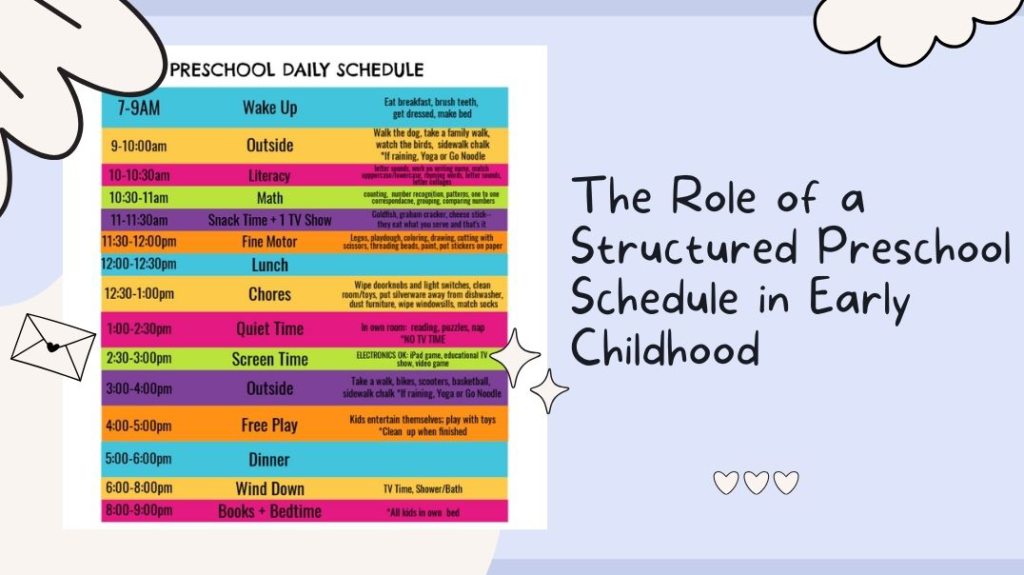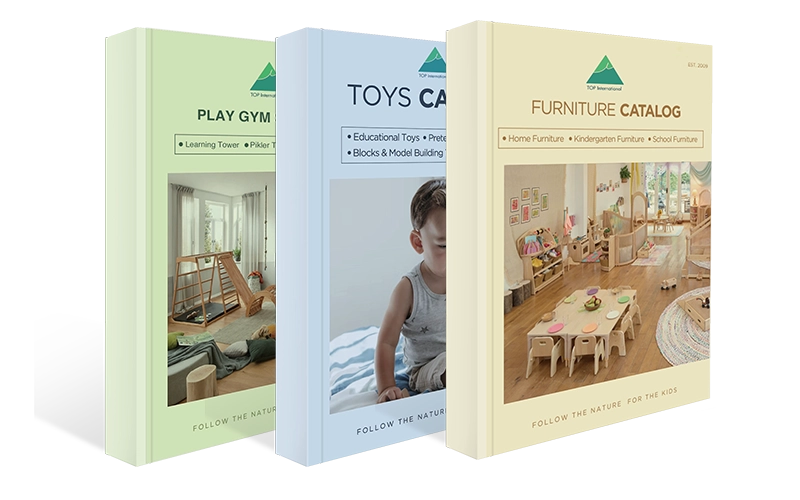Creating the right Preschool Schedule is one of the most important steps in supporting a child’s early development. During these formative years, children need more than just play or academic instruction—they need a balance that allows them to grow socially, emotionally, and cognitively. A thoughtfully designed daily routine ensures that children have time to explore, learn, rest, and interact, all while feeling secure in the predictability of their day.
For parents and educators, the challenge often lies in finding the right balance. Too much focus on structured learning can overwhelm young minds, while too much free play may leave gaps in foundational skills. The key is a Preschool Schedule that harmonizes play, learning, and rest, creating an environment where children can thrive both academically and emotionally.
In this article, we’ll explore why balance matters, what elements should be included in a preschooler’s daily schedule, and how to design a routine that meets both educational goals and a child’s natural needs. Whether you’re a teacher managing a classroom or a parent looking for structure at home, this guide will provide practical insights and expert-backed strategies to make every day meaningful and well-rounded.
Why Use a Preschool Daily Schedule?
Running a classroom without a consistent preschool schedule is like navigating a ship without a compass. A well-structured preschool class schedule provides predictability and security, essential for young children. At an age where routines shape emotional stability, having a preschool schedule chart or pictorial schedule helps children navigate their day confidently.
Children thrive on routine. When there is a consistent preschool day schedule, children learn what to expect and when to expect it. This reduces anxiety and increases their ability to focus on the activity. Whether it’s circle time, snack time, or outdoor play, a daily preschool schedule helps children anticipate transitions and respond more positively to changes.
Even parents notice the difference. Children who attend a preschool with a dependable daily schedule tend to have better sleep routines, handle transitions at home more easily, and feel more confident overall. If you’re developing a new center or revising your curriculum, investing time in crafting a solid preschool homeschool schedule or full-day schedule can make all the difference.
Moreover, structure doesn’t mean rigidity. Using tools like a printable preschool schedule or customizable preschool schedule printables allows you to adapt the routine to your group’s evolving needs.

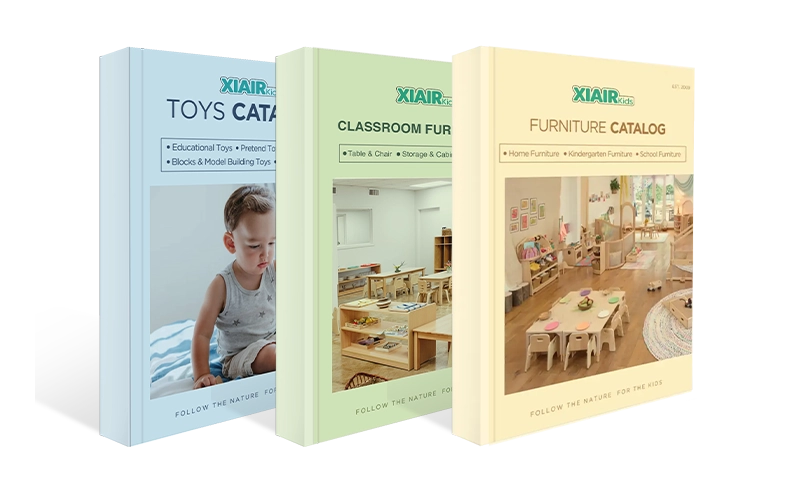
Receive a free catalog and custom layout to help you design your ideal classroom easily.
How Does a Daily Schedule Benefit Preschoolers’ Development?
An intentional daily schedule in the preschool environment supports every developmental domain. Below, we explore how implementing a typical preschool schedule benefits early childhood growth across physical, emotional, cognitive, and social domains.
Emotional Stability
Consistency in daily routines provides children with a sense of security and predictability. When children know what to expect, they are less likely to experience anxiety and more likely to engage positively in activities. A daily preschool schedule that includes regular times for meals, play, and rest helps children regulate their emotions and develop coping mechanisms.
Sense of Control
Empowering children with control over their environment is essential for building self-confidence. Following a preschool class schedule teaches children to anticipate events, make decisions, and take responsibility for their actions. This autonomy fosters independence and encourages active participation in their learning journey.
Transitions and Time Management
Smooth transitions are one of the hallmarks of a successful preschool schedule. Children learn how to manage their time when they move from one activity to the next using a precise, predictable flow, supported by tools like a daily routine picture schedule for preschool.
Habilidades sociales
Structured schedules provide ample opportunities for children to interact with peers, enhancing their social development. Activities like group play, circle time, and collaborative projects, for example, within a preschool schedule, encourage communication, cooperation, and empathy among children. These interactions are vital for honing communication skills and building lasting relationships.

Desarrollo cognitivo
Scheduled academic time within a preschool homeschool schedule gives children space to absorb new concepts, whether counting blocks, recognizing letters, or asking “why.” Cognitive skills develop in planned learning blocks.
Desarrollo físico
A daily preschool schedule includes time for movement. Physical development is essential, whether through outdoor recess or structured motor skills. Balanced routines should consist of both gross and fine motor activities. Using a preschool schedule with a full-day approach ensures children get active movement and rest equally. Planning blocks of time for dancing, climbing, or yoga supports extensive muscle development, while art, puzzles, and blocks strengthen fine motor control.
Language and Literacy
A consistent routine that includes reading sessions, singing, and conversations supports language acquisition and literacy skills. A pictorial schedule for preschool can also aid vocabulary development as children associate images with words and actions. Regular exposure to books and story-based interactions within a structured daily preschool schedule reinforces comprehension, narrative skills, and expressive language. When planned into the preschool schedule template, these literacy-rich environments foster a genuine love for reading and early writing confidence.

Self-Help Skills
Daily routines allow children to practice self-help skills such as dressing, feeding, and tidying up. By integrating these tasks into the preschool daily schedule template, children learn to care for themselves and their environment, fostering independence and responsibility. Activities like handwashing before meals or packing away toys after play become habitual when included in a daily schedule in preschool. Over time, these practices build a child’s confidence, autonomy, and readiness for more advanced routines in kindergarten and beyond.
Behavior Management
Predictable schedules help manage children’s behavior by setting clear expectations and reducing uncertainties. A sample preschool daily schedule that includes structured activities and designated times for free play can minimize behavioral issues and promote positive conduct. When children understand their preschool schedule with pictures, they are more likely to cooperate and less likely to resist transitions. Structured environments support the development of self-discipline and internal motivation, foundational traits for long-term behavioral success.
What Elements Should a Preschool Daily Schedule Include?
A well-balanced preschool schedule is not a one-size-fits-all template. It’s a carefully constructed framework that accommodates children’s developmental needs while allowing flexibility and spontaneity. While different schools may adopt slightly different formats, several essential components should be included in any daily schedule for preschoolers to ensure a well-rounded and enriching day. These core elements ensure children receive the right mix of academic exposure, play, rest, and social interaction.
Circle Time
Circle time is often the first group activity of the day, and it’s a vital cornerstone of any daily preschool schedule. During this period, children sing songs, review the calendar, discuss the weather, and listen to stories. More than just a welcome activity, this sets the tone for the day by establishing structure, encouraging participation, and building classroom community.
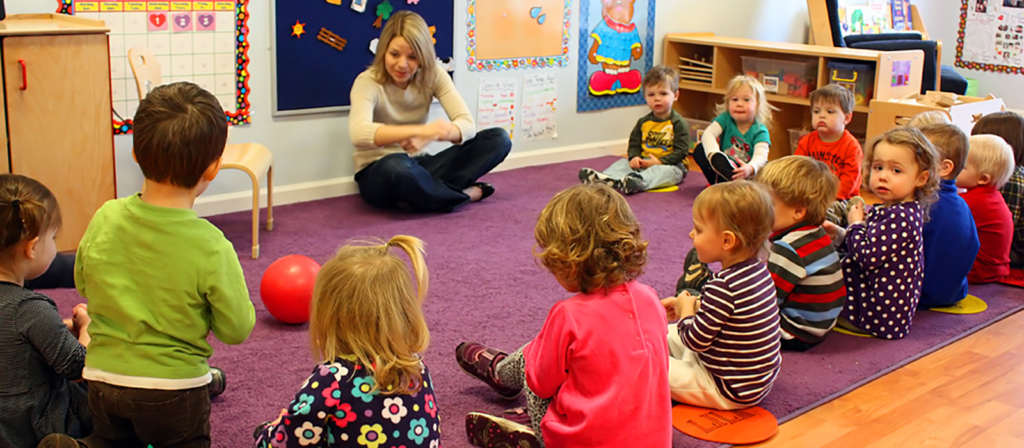
Learning Centers
Learning centers offer self-directed, hands-on experiences that support cognitive and creative development. In a well-structured preschool class schedule, centers are typically part of the morning block, when children are most focused. Centers may include reading, math, art, dramatic play, science, and fine motor activities.

Juego al aire libre
Physical activity is critical in early childhood development, and daily outdoor play is a non-negotiable element of a high-quality preschool schedule. Whether it’s free play on the playground, organized games, or nature walks, this time supports gross motor skills, spatial awareness, and social development. Outdoor play helps release excess energy, reduces stress, and recharges the mind, making children more focused during structured indoor learning times.

Snack Time
Although short, snack time has great developmental value. It’s a time for practicing self-help skills, such as washing hands, pouring drinks, and cleaning up. Children learn table manners, food vocabulary, and social skills during shared meals.
This is a consistent part of preschool’s schedule that supports emotional regulation. Offering a moment to recharge and refuel can prevent meltdowns and boost engagement in subsequent activities.

Rest or Nap Time
In a full-day preschool schedule, rest or nap time is not optional—it’s necessary. Young children need rest to process their learning, restore energy, and regulate their mood. Depending on age, rest periods may vary from 45 minutes to 2 hours.
Even if a child doesn’t sleep, quiet time should be respected and enforced. Soft lighting, calm music, or story recordings help create a restful environment. This section of the preschool picture schedule can include icons like pillows, blankets, or closed eyes to communicate expectations visually.

Structured Learning Activities
These teacher-led activities may include direct instruction, story comprehension, number games, or science experiments. In a solid preschool daily schedule template, structured learning should follow physical activity or snack time, when attention spans are refreshed.
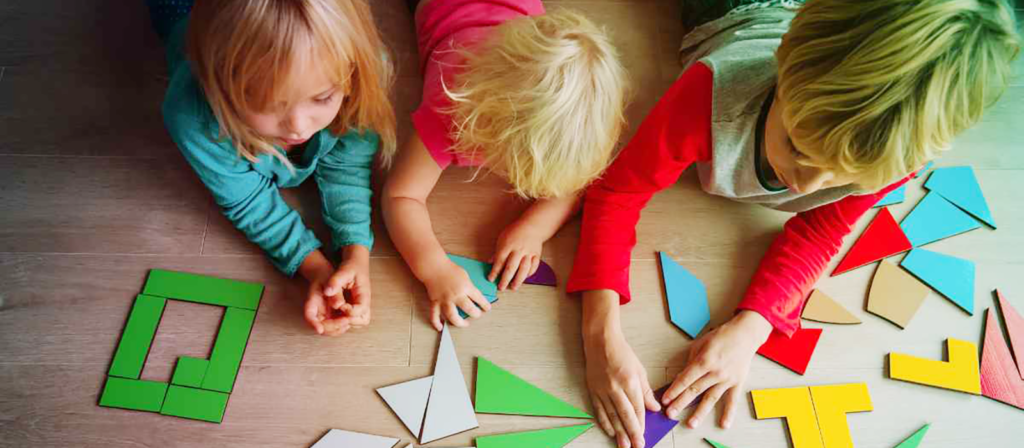
Juego libre
Often undervalued, free play is where children practice everything they’ve learned. It’s unstructured, imaginative, and essential. Children may build with blocks, role-play, explore art supplies, or revisit learning centers during this time.
Your preschool schedule with pictures should show free play clearly, so children learn to anticipate and value it. Allow at least 30 minutes of uninterrupted play for children to become fully immersed. More extended periods may lead to deeper engagement and more complex social interaction.

Transitions
While not an “activity,” transitions are just as important as the significant blocks of the day. Young children often struggle with moving from one task to another, particularly if they are deeply engaged or unsure of what comes next. Teachers can reduce confusion and behavioral issues by integrating marked transitions into the preschool schedule with pictures.
Transition songs, countdowns, or visual timers help children prepare mentally and emotionally for change. Smooth transitions improve overall classroom flow and support emotional self-regulation.

Receive a free catalog and custom layout to help you design your ideal classroom easily.
How to Create a Structured Preschool Schedule?
Creating a thoughtful and responsive preschool schedule involves more than printing a template and filling it in. It requires a deep understanding of your classroom’s needs, teaching goals, and the rhythm that best supports child development.
Establish Preschool Schedule Basics
Start by identifying your non-negotiables: arrival time, meals, outdoor play, rest time, and departure. Then, consider developmental needs. A preschool daily schedule example should support short attention spans, active bodies, and emotional transitions.
Break the day into manageable blocks. For example, in a preschool schedule, mornings might begin with arrival, circle time, and centers, while afternoons involve rest, outdoor play, and storytime. Use a sample preschool schedule to guide your timing—30 to 45 minutes per activity is usually ideal.
Use Flexibility to Your Advantage
While routine is key, too much rigidity can lead to frustration. A great preschool homeschool schedule or classroom plan leaves space for spontaneity—extending storytime if the children are engaged, or shortening a lesson if attention wanes.
Adapting based on children’s moods, needs, or unexpected events shows responsiveness. A structured schedule doesn’t mean a strict schedule—it’s a guide, not a prison. Flexibility within boundaries is the secret to sustainability in both home and school environments.
If the weather disrupts outdoor time, have indoor gross motor alternatives ready. If a special visitor arrives, weave them into the preschool classroom schedule. A schedule is most potent when it serves as a tool rather than a constraint.
Manage Transitions
Transitions need planning. Build time into your daily preschool schedule for cleaning up, preparing for lunch, and toileting. Use the same cues consistently, whether visual (picture icons), auditory (music), or physical (movement breaks).
Children thrive when expectations are clear. Use preschool schedule pictures or post your preschool schedule chart at their eye level. Narrate transitions clearly (“After cleanup, we’ll line up for recess”) so children mentally prepare.
If you’re building a preschool homeschool schedule, managing transitions becomes a way to teach executive function. Let children help lead the schedule with a pointer or calendar—this adds ownership and predictability.
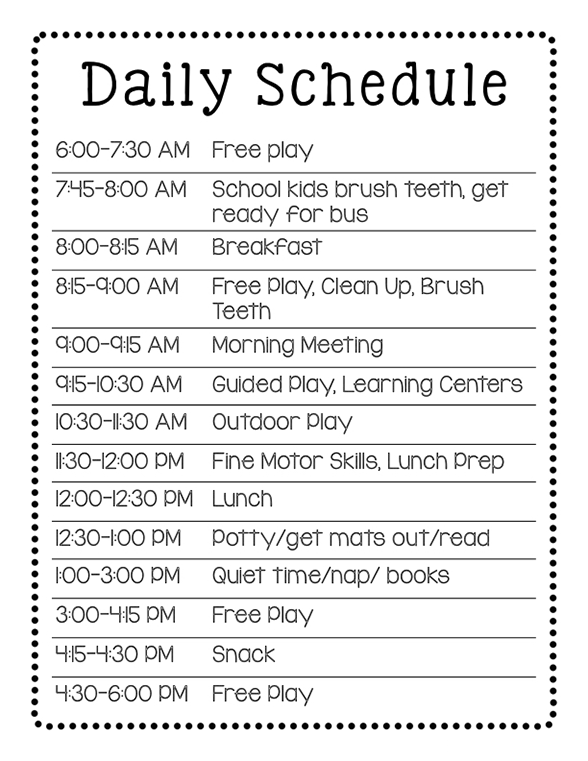


Receive a free catalog and custom layout to help you design your ideal classroom easily.
Creating a Balanced Daily Schedule for Preschoolers
Creating a Balanced Daily Schedule for Preschoolers focuses on designing structured yet flexible routines that support young children’s emotional, cognitive, social, and physical development throughout the day.
Reggio Emilia Preschool Schedule
| Time | Activity | Descripción |
|---|---|---|
| 8:00 AM – 8:30 AM | Arrival and Free Exploration | Children arrive, greet teachers, and freely explore classroom materials. |
| 8:30 AM – 9:00 AM | Morning Meeting (Circle Time) | Healthy snack fosters independence and social development. |
| 9:00 AM – 10:15 AM | Project Work / Learning Centers | Reggio-style inquiry projects and exploration through hands-on activities. |
| 10:15 AM – 10:30 AM | Snack Time | Communal mealtime with a focus on self-help, hygiene, and conversation. |
| 10:30 AM – 11:30 AM | Outdoor Play / Nature Exploration | Physical and social play in a natural environment or outdoor playground. |
| 11:30 AM – 12:00 PM | Documentation / Reflection Time | Children reflect on morning projects through drawing, storytelling, etc. |
| 12:00 PM – 12:45 PM | Lunch | Wash-up, quiet music, or a story to ease into rest time. |
| 12:45 PM – 1:00 PM | Transition and Rest Preparation | A light snack to restore energy after rest. |
| 1:00 PM – 2:30 PM | Rest or Quiet Time | Naptime or independent quiet activities like reading or drawing. |
| 2:30 PM – 3:00 PM | Afternoon Snack | Light snack to restore energy after rest. |
| 3:00 PM – 3:45 PM | Free Play / Extended Projects | Continuation of morning projects or self-directed creative play. |
| 3:45 PM – 4:15 PM | Group Games or Studio Time | Teacher-guided collaborative play, music, or art studio exploration. |
| 4:15 PM – 4:30 PM | Closing Circle and Dismissal | Calm group reflection, end-of-day sharing, and preparation for pickup. |
Key Features of the Reggio Emilia Preschool Routine:
- Project-Based, Child-Driven Learning: The Reggio Emilia daily routine revolves around projects that emerge from children’s interests and questions. These projects evolve and encourage deep exploration and investigation.
- Extended Work Time: Like Montessori, the Reggio Emilia schedule allows for long, uninterrupted work periods, allowing children to engage fully with activities, materials, and projects without being rushed.
- Aprendizaje colaborativo: Emphasis is placed on small group work where children engage in cooperative projects. This encourages social learning, problem-solving, and sharing ideas between peers.
- Environment as the Third Teacher: The classroom environment in Reggio Emilia is thoughtfully designed with open-ended materials and natural elements to encourage exploration and creativity, fostering both independent and group learning.

Montessori Preschool Schedule
| Time | Activity | Descripción |
|---|---|---|
| 8:00 AM – 8:30 AM | Arrival and Practical Life Tasks | Light snacks and free time to explore the classroom or outdoor materials are provided. |
| 8:30 AM – 11:00 AM | Montessori Work Cycle (Uninterrupted) | Core learning time. Children choose from language, math, sensorial, practical life, or cultural activities at their own pace. Teachers observe and guide. |
| 11:00 AM – 11:30 AM | Outdoor Play / Gross Motor Time | Free movement outdoors, focused on physical development and social play. |
| 11:30 AM – 12:00 PM | Group Circle / Story Time | Quiet time for stories, songs, calendar, or class discussions. |
| 12:00 PM – 12:45 PM | Lunch | Children eat together, practicing table manners, clean-up, and independence. |
| 12:45 PM – 1:00 PM | Transition and Rest Preparation | Calm music or books help children transition to rest time. |
| 1:00 PM – 2:30 PM | Rest or Quiet Work | Naptime for younger children; older children engage in quiet work or reading. |
| 2:30 PM – 3:00 PM | Snack and Independent Play | Light snacks are provided, and there is free time to explore the classroom or outdoor materials. |
| 3:00 PM – 3:45 PM | Enrichment Activities | Rotating activities: art, music, foreign language, or nature studies. |
| 3:45 PM – 4:30 PM | Outdoor Exploration / Dismissal | Light snacks and free time to explore the classroom or outdoor materials are provided. |
Key Features of the Montessori Daily Routine:
- Uninterrupted Work Period (usually 2.5 to 3 hours in the morning) is the cornerstone of the Montessori preschool schedule template. It enables children to enter deep focus and complete meaningful work without distraction.
- Freedom within structure: Though children choose their work, the environment and schedule are precisely designed to guide independence and order.
- Mixed-age classrooms: Schedules are adjusted to meet the needs of 3–6-year-olds, supporting peer learning and leadership opportunities.
- Minimal group time: Unlike traditional models, the Montessori preschool class schedule limits group instruction to preserve individual learning time.

Waldorf Preschool Schedule
| Time | Activity | Descripción |
|---|---|---|
| 8:00 AM – 8:30 AM | Arrival and Free Play | Children arrive, greet teachers, and engage in free, imaginative play. |
| 8:30 AM – 9:00 AM | Morning Circle and Story Time | Group gathering for songs, stories, and an overview of the day’s rhythm. |
| 9:00 AM – 10:30 AM | Artistic and Imaginative Activities | Time for painting, modeling, storytelling, and other creative work. |
| 10:30 AM – 11:00 AM | Snack Time and Social Interaction | Children have a healthy snack while practicing social skills and independence. |
| 11:00 AM – 12:00 PM | Outdoor Play and Nature Walk | Unstructured play outside or a nature walk, encouraging physical and sensory development. |
| 12:00 PM – 12:45 PM | Lunch | A communal, calm mealtime that emphasizes table manners and responsibility. |
| 12:45 PM – 1:00 PM | Transition and Rest Preparation | Quiet activities or a story to prepare children for rest time. |
| 1:00 PM – 2:30 PM | Rest or Quiet Time | Naptime for younger children or quiet, independent activities for older children. |
| 2:30 PM – 3:00 PM | Afternoon Snack | Unstructured play outside or a nature walk encourages physical and sensory development. |
| 3:00 PM – 3:45 PM | Outdoor Exploration / Free Play | Additional outdoor time or free play indoors, focusing on self-directed activities. |
| 3:45 PM – 4:15 PM | Closing Circle and Reflection | Group reflection, share experiences, and discuss the day’s activities. |
| 4:15 PM – 4:30 PM | Dismissal and Preparation for Pickup | A light snack to recharge after resting. |
Key Features of the Waldorf Preschool Daily Schedule:
- Rhythmic Daily Routine: The Waldorf preschool schedule follows a consistent, rhythmic daily routine, creating a sense of security and emotional stability through predictable activities.
- Imaginative Play and Artistic Expression: Imaginative play and artistic activities like storytelling, painting, and modeling encourage creativity, self-expression, and emotional development.
- Outdoor Play and Nature Connection: The schedule includes significant time for outdoor play and nature connection, which promotes physical development and fosters an appreciation for the environment.
- Role of the Teacher as a Model: The teacher is a role model, demonstrating tasks like cooking, cleaning, and handwork for children to observe and imitate.

Receive a free catalog and custom layout to help you design your ideal classroom easily.

Other Preschool Schedule
Special Education Preschool Daily Schedule
| Time | Activity | Descripción |
|---|---|---|
| 8:00 AM – 8:30 AM | Arrival and Sensory Integration | Children arrive and participate in activities designed to regulate sensory needs (e.g., calm music, fidget toys). |
| 8:30 AM – 9:00 AM | Morning Circle and Greeting | A snack period supports independence, social interaction, and language development in a calm environment. |
| 9:00 AM – 9:45 AM | Individualized Learning Time | Focused one-on-one or small group sessions tailored to each child’s needs, supporting academic and therapeutic goals (e.g., speech therapy, fine motor skills). |
| 9:45 AM – 10:15 AM | Snack Time and Social Interaction | A snack period supports independence, social interaction, and language development in a calm environment. |
| 10:15 AM – 11:00 AM | Sensory Break / Gross Motor Play | Rotating activities focusing on specific skills, such as art, math, or literacy, in a sensory-friendly space with ample adult support. |
| 11:00 AM – 11:30 AM | Learning Centers | Mealtime promotes independent eating skills, social interaction, and communication with peers. |
| 11:30 AM – 12:00 PM | Outdoor Play / Nature Exploration | Time outdoors to explore the environment, practice gross motor skills, and promote socialization. |
| 12:00 PM – 12:45 PM | Lunch | Mealtime promoting independent eating skills, social interaction, and communication with peers. |
| 12:45 PM – 1:00 PM | Rest/Quiet Time | A calming transition time to prepare for rest, with soft music or books to create a peaceful atmosphere. |
| 1:00 PM – 2:00 PM | Individual Therapy or Group Session | Individual or small group therapy sessions tailored to specific needs, such as speech, occupational therapy, or social skills training. |
| 2:00 PM – 2:30 PM | Afternoon Snack and Free Play | Mealtime promotes independent eating skills, social interaction, and communication with peers. |
| 2:30 PM – 3:00 PM | Story Time and Group Activity | Group storytelling and activities that encourage listening, following instructions, and building language skills. |
| 3:00 PM – 3:30 PM | Sensory Break and Transitions | A sensory break followed by activities that help with transitions, like using a visual schedule to prepare for departure. |
| 3:30 PM – 4:00 PM | Closing Circle and Dismissal | Group reflection, calming activities, and saying goodbye to prepare for home. |
Key Features:
- Structured and Individualized: The schedule is highly structured to provide stability, with personalized adjustments based on each child’s specific needs, offering additional support where required.
- Integración sensorial: The schedule includes sensory integration activities, such as quiet spaces or specific sensory toys, to help children regulate their sensory needs.
- Short Learning and Break Periods: Given the attention span of young children, learning and activity periods are often brief, with frequent breaks and transition times to keep children engaged.
- Individual Therapy and Small Group Activities: The schedule incorporates individual therapy sessions (e.g., speech therapy, occupational therapy) and small group activities to promote social skills and teamwork.
These features ensure that children can learn effectively in a supportive environment while developing social, emotional, and academic skills.
Half-Day Preschool Schedule
| Time | Activity | Descripción |
|---|---|---|
| 8:00 AM – 8:15 AM | Arrival and Free Play | Children arrive, greet teachers, and engage in free play with classroom materials. |
| 8:15 AM – 8:30 AM | Morning Circle and Welcome | A structured group time to sing songs, discuss the day’s activities, and help children transition into the schedule. |
| 8:30 AM – 9:15 AM | Learning Centers / Group Work | Outdoor exploration or physical play can help build coordination, strength, and social skills. |
| 9:15 AM – 9:30 AM | Snack Time | A snack break where children practice social skills and independence while having a light, healthy snack. |
| 9:30 AM – 10:00 AM | Outdoor Play or Gross Motor Activity | Children can express their creativity through independent play or a guided art activity (painting, drawing, etc.). |
| 10:00 AM – 10:30 AM | Story Time and Group Activity | A calming activity that includes reading stories aloud, followed by a group discussion or related activity. |
| 10:30 AM – 11:00 AM | Free Play or Art Time | Children rotate through learning centers focused on math, literacy, art, or science. Teachers guide group activities. |
| 11:00 AM – 11:15 AM | Clean-up and Snack | Time to clean up the classroom and get ready for departure. Children have a light snack before leaving. |
| 11:15 AM – 11:30 AM | Closing Circle and Dismissal | Children rotate through learning centers focused on areas like math, literacy, art, or science. Teachers guide group activities. |
Key Features:
- Compact and Focused: The schedule is designed for a shorter day, usually 3-4 hours, focusing on key activities like learning, play, and social interaction within that limited time.
- Balanced Learning and Play: It balances structured learning time (such as math, language, and arts) with free play, allowing children to explore, create, and engage with peers.
- Desarrollo social y emocional: Emphasis is placed on developing social skills through group activities, snack time, and sharing experiences.
- Quick Transitions: The schedule includes clear transitions between activities to maintain children’s focus and provide a smooth flow between learning, play, and rest.
This schedule allows for an enriching, engaging experience that prepares children for school while ensuring adequate time for rest and play.
Homeschool Preschool Schedule
| Time | Activity | Descripción |
|---|---|---|
| 8:30 AM – 9:00 AM | Arrival and Free Play | A communal lunch break fosters independence and healthy eating habits. |
| 9:00 AM – 9:30 AM | Morning Circle and Learning Focus | A group gathering for songs, calendar review, and an introduction to the day’s learning theme (e.g., colors, animals, numbers). |
| 9:30 AM – 10:15 AM | Learning Activities (Math/Language) | Children start the day by engaging in free play and exploring educational toys or materials. |
| 10:15 AM – 10:30 AM | Snack Time | A break for a healthy snack, where children can practice eating independently and engage in social conversation. |
| 10:30 AM – 11:00 AM | Outdoor Play / Gross Motor Time | A communal lunch break fosters independence and healthy eating habits. |
| 11:00 AM – 11:30 AM | Creative Arts and Free Exploration | Physical activities such as running, jumping, climbing, or outdoor exploration support gross motor skills and socialization. |
| 11:30 AM – 12:00 PM | Story Time and Quiet Time | Reading a story or engaging in a quiet activity, followed by a short rest or calm time to relax and prepare for the end of the day. |
| 12:00 PM – 12:30 PM | Lunch | The group will reflect on the day’s activities, share favorite moments, and prepare for the rest of the day. |
| 12:30 PM – 1:00 PM | Free Play / Independent Work | A period for self-directed play or simple independent tasks (e.g., puzzles, matching games). |
| 1:00 PM – 1:30 PM | Closing Circle and Reflection | Group reflection on the day’s activities, sharing favorite moments, and preparing for the rest of the day. |
Key Features:
- Flexible Structure: The schedule can be easily adjusted to fit the family’s daily routines, balancing structured educational activities and flexible free time for exploration.
- Personalized Learning: Learning is tailored to the child’s individual pace and developmental needs, allowing for one-on-one attention and customized lessons based on their interests and strengths.
- Learning Through Play: Activities are designed to integrate hands-on learning with play, promoting creativity, social skills, and problem-solving in an engaging, natural way.
- Frequent Breaks: Regular breaks are scheduled throughout the day to ensure children stay refreshed and engaged. These breaks include time for rest, snacks, and physical activities like outdoor play.
- Family Involvement: Parents are directly involved in the learning process, providing guidance and support, and fostering a close-knit learning environment with strong family bonds.
This structure offers a flexible, child-focused learning environment, where education adapts to the child’s needs and family lifestyle.
Preschool Cleaning Schedule
| Time | Activity | Descripción |
|---|---|---|
| Before School | General Classroom Clean-Up | Wipe down tables, chairs, and shelves; sanitize toys and learning materials; vacuum or sweep floors. |
| After Snack Time | Snack Area Clean-Up | Sweep and sanitize outdoor play equipment, clean the sandbox or other play areas, and ensure safety. |
| Midday (Before Nap) | Restroom and Changing Area Cleaning | Clean and sanitize bathrooms, restock supplies (toilet paper, soap, towels), and wipe down changing tables. |
| After Art Time | Art Area Clean-Up | Wash paintbrushes, wipe down art stations, and clean any spills or messes made during creative activities. |
| After Outdoor Play | Outdoor Area Cleaning | Wipe down all surfaces (tables, chairs, shelves, windows), vacuum or sweep floors, sanitize toys and materials, and remove the trash. |
| End of Day | Full Classroom Clean-Up | Wipe down all surfaces (tables, chairs, shelves, windows), vacuum or sweep floors, sanitize toys and materials, take out the trash. |
| Weekly | Deep Clean | Clean windows, disinfect carpets, deep clean rugs or cushions, sanitize all toys and materials, wash curtains, and check for safety hazards. |
Key Features:
- Daily Tasks: Ensure cleanliness after each activity and throughout the day.
- Sanitization: Focus on sanitizing surfaces and toys to maintain a safe environment for young children.
- Special Areas: Allocate time to clean specific areas such as snack tables, art areas, and restrooms, which are high-touch areas.
- Weekly Deep Cleaning: Include more thorough cleaning once a week to address areas that need more attention.
Preschool Daycare Schedule
| Time | Activity | Descripción |
|---|---|---|
| 7:30 AM – 8:00 AM | Arrival and Free Play | Children arrive, greet teachers, and engage in quiet, independent play or sensory activities. |
| 8:00 AM – 8:30 AM | Morning Circle | Group gathering for songs, calendar, and introductions to the day’s activities. |
| 8:30 AM – 9:30 AM | Learning Centers | Children rotate through learning centers focused on math, literacy, or the arts. |
| 9:30 AM – 10:00 AM | Snack Time | A healthy snack break where children practice self-regulation and social skills. |
| 10:00 AM – 10:45 AM | Juego al aire libre | Time for outdoor activities, gross motor development, and exploration. |
| 10:45 AM – 11:15 AM | Group Activity / Story Time | Group activity or reading time to promote socialization and listening skills. |
| 11:15 AM – 12:00 PM | Creative Arts / Free Play | Time for children to engage in arts and crafts, or choose activities in a designated play area. |
| 12:00 PM – 12:30 PM | Lunch | Children rotate through learning centers focused on math, literacy, or arts. |
| 12:30 PM – 1:00 PM | Rest / Quiet Time | A period for rest or quiet activities like listening to soft music, looking at books, or napping. |
| 1:00 PM – 2:00 PM | Learning or Therapy Sessions | Individual or small group activities focusing on language, social skills, or therapeutic exercises (e.g., speech therapy). |
| 2:00 PM – 2:30 PM | Snack and Independent Play | Light snack and free play time for children to explore or engage in self-directed activities. |
| 2:30 PM – 3:30 PM | Outdoor Play / Gross Motor Time | Communal mealtime is where children practice eating independently and engage in social interaction. |
| 3:30 PM – 4:00 PM | Closing Circle and Dismissal | Additional outdoor play or activities are designed to improve coordination and teamwork. |
Key Features:
- Balanced Routine: A combination of structured activities and free play to engage the mind and body.
- Focus on Socialization: Through group activities, snack time, and outdoor play, children develop key social skills like sharing and cooperation.
- Frequent Outdoor Time: Ensures physical development and a connection with nature.
- Naps and Quiet Time: A restful period is included to help children recharge, especially in a full-day schedule.


Receive a free catalog and custom layout to help you design your ideal classroom easily.
Preguntas frecuentes
1. What is the difference between full- and half-day preschool schedules?
A full-day schedule lasts 6-8 hours, including extended learning, outdoor play, rest, and meals. A half-day schedule lasts 3-4 hours and focuses on key activities like learning centers, circle time, and snacks.
2. How do special education preschool schedules differ from typical preschool schedules?
Special education schedules are tailored with extra therapy sessions, sensory breaks, and shorter, focused learning periods, providing more support for individual needs.
3. What types of activities are included in a homeschool preschool schedule?
A homeschool schedule includes learning through play, arts, story time, sensory activities, outdoor exploration, and family interaction, tailored to the child’s interests and pace.
4. How can I create a balanced preschool schedule at home?
Include structured learning (math, art), free play, outdoor activities, snack breaks, and quiet time, with flexibility to adapt to your child’s needs.
5. Why is a preschool cleaning schedule important?
A cleaning schedule ensures a safe, hygienic environment, reduces illness risks, and keeps the classroom organized for learning and play.
6. What should be included in a preschool daycare schedule for different age groups?
For younger children, focus on short learning sessions, breaks, and sensory activities. Older children benefit from extended work periods, group play, and rest.
7. How do preschool schedules accommodate children with varying attention spans?
Schedules balance short learning periods, playtime, and sensory breaks, allowing children to stay engaged and avoid frustration.
Conclusión
A preschool schedule is essential for creating a structured yet flexible learning environment that supports young children’s development. Whether it’s a Montessori, Reggio Emilia, Waldorf, or special education preschool schedule, each approach has unique features tailored to the children’s needs.
Key elements across various schedules include structured learning time, creative play, outdoor activities, and regular snack and rest periods. For homeschooling, flexibility is key, with schedules adapted to a child’s pace, allowing for personalized, one-on-one attention. Half-day schedules balance activities within a shorter timeframe, while daycare schedules cater to a broader range of needs and age groups.
Cleaning schedules are critical in ensuring a safe and hygienic environment for children. At the same time, frequent breaks and social interaction opportunities are essential to keep children engaged and focused throughout the day.
Ultimately, a well-designed preschool schedule helps children thrive by fostering learning, independence, and social skills, all within a structured yet adaptable routine.

